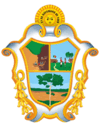Manaus
| Manaus | |||
| — Municipality — | |||
| The Municipality of Manaus | |||
|
|
|||
|
|||
| Nickname(s): "A Paris dos Trópicos" ("The Paris of the Tropics") | |||
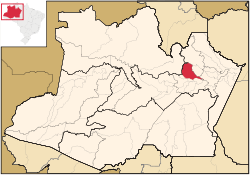 |
|||
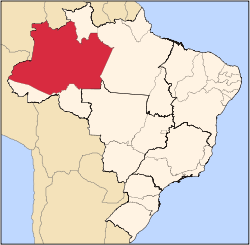 |
|||
| Country | |||
|---|---|---|---|
| Region | North | ||
| State | |||
| Founded | 1669 | ||
| Government | |||
| - Mayor | Serafim Corrêa (PSB) | ||
| Area | |||
| - Total | 11,401 km² (4,402 sq mi) | ||
| Elevation | 92 m (302 ft) | ||
| Population (2007) | |||
| - Total | 1,709,010 (8th) | ||
| - Density | 144.2/km² (19,611/sq mi) | ||
| Time zone | AST (UTC-4) | ||
| - Summer (DST) | DST no longer used (UTC-4) | ||
| HDI (2000) | 0.774 – medium | ||
| Website: Manaus, Amazonas | |||
Manaus is a city in the northern part of Brazil, and is the capital of Amazonas State. Located on the Rio Negro near its confluence with the Rio Solimões (also known as the Amazon River), it is the chief port and a hub for the region's extensive river system. It is also a common point of departure for tourists visiting the rest of the Amazon region.
Situated on the banks of the Rio Negro (meaning Black River, because of the dark color of the water), Manaus is an important centre for ecological tourism. One of its most popular attractions is the Ponta Negra beach, 13 kilometres (8 miles) from the centre of the city, where, when the river is low, the sands are exposed right down to the river bed, forming a contrast with the dark waters of the river itself.
There is also the forested area of the National Research Institute of Amazônia (INPA), a complex made up of the Botanical Gardens, rich in plant species from the Amazon region, and the Zoological Gardens, which contain various animal species of the region, including some facing extinction.
The old rubber barons dreamed of transforming it into a European style city and called it "The Paris of the Tropics". With the end of the rubber boom, Manaus went into decline and only entered a period of renewed development in the 1950s. A turning point was reached in 1967, when the Manaus Free Zone was established by the federal government.
From that date on, the capital of Amazonas has passed through great changes, becoming an important industrial centre for the manufacture of electrical and electronic goods (nowadays, Manaus is the supplier for the entire country of, e.g., DVD players and computer monitors).
Contents
|
Geography
| for Manaus | |||||||||||||||||||||||||||||||||||||||||||||||
|---|---|---|---|---|---|---|---|---|---|---|---|---|---|---|---|---|---|---|---|---|---|---|---|---|---|---|---|---|---|---|---|---|---|---|---|---|---|---|---|---|---|---|---|---|---|---|---|
| J | F | M | A | M | J | J | A | S | O | N | D | ||||||||||||||||||||||||||||||||||||
|
201
30
23
|
188
30
23
|
191
30
23
|
211
30
24
|
158
31
23
|
118
31
23
|
40
31
23
|
39
32
23
|
60
33
24
|
63
33
23
|
106
32
23
|
130
31
24
|
||||||||||||||||||||||||||||||||||||
| temperatures in °C precipitation totals in mm source: MSN Weather |
|||||||||||||||||||||||||||||||||||||||||||||||
|
Imperial conversion
|
|||||||||||||||||||||||||||||||||||||||||||||||
Climate
An equatorial climate is a type of tropical climate in which there is no dry season – all months have mean precipitation values of at least 60mm. It is usually found at latitudes within five degrees of the equator – which are dominated by the Intertropical Convergence Zone. The equatorial climate is denoted Af in the Köppen climate classification.
Tropical rainforest is the natural vegetation in equatorial regions. Although Manaus meets the technical requirements for "Am", or monsoon rainforest, in the Köppen climate classification, Neotropical areas are not usually referred to as monsoon rainforest.
Vegetation
The Amazon represents over half of the planet's remaining rainforests and comprises the largest and most species-rich tract of tropical rainforest in the world. Wet tropical forests are the most species-rich biome, and tropical forests in the Americas are consistently more species rich than the wet forests in Africa and Asia.[1] As the largest tract of tropical rainforest in the Americas, the Amazonian rainforests have unparalleled biodiversity. More than 1/3 of all species in the world live in the Amazon Rainforest.[2]
History
Manaus began as a small fort, São José da Barra, created in 1669 by Portuguese settlers. An Indian village was spawned around the fort and was given the name “Sao Jose da Barro do Rio Negro” since it was banked on the River Negro. A fortress had been constructed to prevent the descending of the Dutch invaders garrisoned in Suriname (former Dutch Guyana) and guarantee the domain of the Portuguese Crown in the region. The settlement that developed around the fortress was given the name of São José da Barra do Rio Negro (Lugar da Barra) and in 1832, under denomination of Nossa Senhora da Conceição da Barra do Rio Negro, the settlement was raised to the status of Villa (small town). In 1848, the small town of Vila da Barra was raised to the status of City, with the name Cidade da Barra do Rio Negro, finally receiving the name Manaus, in 1856, to celebrate the Manáo (Mother of the gods) Indian nation, the most important ethnic group in the region, historically acknowledged by their courage and bravery.
Between 1890 and 1910, thanks to the exportation of natural rubber, the local businessmen and rulers brought in from the Europe hundreds of architects and landscape painters, for the execution of an ambitious urban plan that would result in a city with European architectonic profile, though embedded in the middle of the jungle. Modern and innovative, Manaus was one of the first Brazilian cities to have electricity, pluvial drainage system, water treatment, sewer system and electric streetcar service. For over a hundred years ago Manaus inaugurated the Amazonas Opera House which astonished the world for its luxury, refinement and architectonic beauty, and in 1909 the first Brazilian University was founded - the Universidade Livre de Manaus (Autonomous University of Manaus). The floating harbor, built to adapt to the tidal water level of the rivers, was totally imported from England. Several other public buildings were also imported from England. With the establishment of the Free Zone, in 1967, Manaus took advantage of the fiscal incentives to become the largest existing commercial and industrial sector on the Equator.
The main Brazilian industries of electric-electronic appliances, clocks and watches, bicycles, motorcycles, eyeglasses, etc., are concentrated here. Commerce offers a wide variety of high technology products, at the lowest prices and the hotels are equipped to efficiently receive people from everywhere in the country and overseas.
Public investment in the urban infrastructure has made possible the emerging of an increasingly beautiful and welcoming city. Manaus has also become an important hub for Ecotourism thanks to its natural beauties and the rescue of the Indigenous traditions, which have in the exuberance of the boi-bumbá festivals one of its main examples. The boi-bumbá festivals, which date back to the beginning of the 20th century, has been given a new style and has been conquering the hearts and minds of thousands of people in Brazil and overseas.
Economy

Although the main industry of Manaus through much of the 20th century was rubber, its importance has declined. Given its location, timber and Brazil-nuts make up important trades, as do petroleum refining, soap manufacturing, and chemical industries. Over the last decades, a system of federal investments and tax incentives have turned the surrounding region into a major industrial center (the Zona Franca of Manaus).
Manaus sprawls, but the center of town, the Centro where most of the hotels and attractions are located, rises above the river on a slight hill. As the largest city and a major port on the river, Manaus is commercial. Local industries include brewing, shipbuilding, soap manufacturing, the production of chemicals, the manufacture of electronics equipment, and petroleum refining of oil brought in by barge. And tourism.[3]
The mobile phone companies Nokia, Sagem, Gradiente and BenQ-Siemens run mobile phone manufacturing plants in Manaus. Also, many other major electronics manufacturers such as Samsung, Sony and LG have plants there. Plastic lens manufacturer Essilor also has a plant here.
The GDP for the city was R$ 27,214,213,000 (2005).[4]
The per capita income for the city was R$ 16,547 (2005).[5]
Sites and attractions
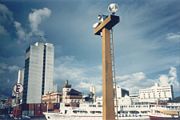
Manaus is a cosmopolitan city, and, because of its location next to the Amazon rain forest, it attracts a substantial number of Brazilian and foreign tourists, who can find plenty of boat and land trips into the surrounding jungle. A great diversity of wildlife can be found even in the surroundings of Manaus. It is also home to one of the most endangered primates in Brazil, the Pied tamarin.
Tour boats leave Manaus to see the Meeting of the Waters, where the black waters of the Negro River meet the brown waters of the Solimoes River, flowing side by side without mixing for about 9 km. Visitors can also explore river banks and "igarapes", swim and canoe in placid lakes or simply walk in the lush forest. The most adventurous may even choose to spend a night or two in the jungle in close contact with nature. There are many hotels in the jungle with the comfort to enjoy the nature.
The Teatro Amazonas, an opera house built in 1896, is a notable landmark of Manaus, reflecting the massive wealth of the turn of the century rubber boom. The theatre was prominently featured in Werner Herzog's 1982 film Fitzcarraldo. The exuberant interior of this 1896 opera house, completed after 15 years, contains crystal chandeliers, wrought-iron banisters, and Italian frescoes, as well as a museum.
About 18 km (11 mi) from downtown is Ponta Negra beach, a neighbourhood that has a beachfront and popular nightlife area. A luxurious hotel is located at the west end of Ponta Negra; its small but very interesting zoo and orchid greenhouse as well as preserved woods and beach are open for public visits.
The CIGS Zoo (military zoo for rescued animals), which doubles as an army training center, also is located in the neighbourhood and houses a few hundred endemic and native amazonian species of mammals, reptiles, and birds.
The Mercado Adolpho Lisboa, founded in 1882, is the city's oldest marketplace, trading in fruit, vegetables, and especially fish. It's a copy of the Les Halles market of Paris. Other interesting historical sites include the customs building, of mixed styles and medieval inspiration; the Rio Negro Palace cultural center; and the Justice Palace, right next to the Amazonas Opera House.
Manaus has also many large parks with native forest preservation areas, such as the Bosque da Ciência and Parque do Mindú. The largest urban forest in the world is located within Federal University of Amazonas [1], which was founded in January 17, 1909 and is the oldest federal university of Brazil.
The city has a busy cultural calendar throughout the year, including the Opera, Theater, Jazz and Cinema festivals, as well as Boi Manaus (usually held around Manaus' anniversary on the 24th of October), which is a great celebration of Northern Brazilian culture through Boi-Bumbá music.
Much of Fitzcarraldo was shot in or near Manaus.
Education
Educational institutions
Universites, Colleges and superior education institutions:
- Federal University of Amazonas - Universidade Federal do Amazonas
- University of the State of Amazonas - Universidade do Estado do Amazonas
- Federal Center of Technological Education - Centro Federal de Educação Tecnológica
- Centro Universitário do Norte - UNINORTE
- Luteran University of Brazil - Universidade Luterana do Brasil
- Centro de Educação Integrada Martha Falcão
- Centro de Ensino Superior Nilton Lins
- Centro Universitário de Educação Superior do Amazonas - CIESA
- Escola Superior Batista do Amazonas
- Faculdade Boas Novas
- Faculdade Metropolitana de Manaus
- Universidade Paulista
Infrastructure
International Airport
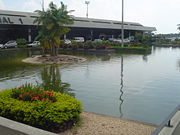
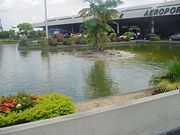
Eduardo Gomes International Airport is the airport serving Manaus. The airport has two passenger terminals, one for scheduled flights and the other for regional aviation. It also has three cargo terminals: Terminal I was opened in 1976, Terminal II in 1980 and Terminal III in 2004. Passenger Terminal I has six boarding bridges, five of them fixed and one mobile, along with three boarding lounges for domestic flights and one for international connections, six domestic and two international gate holding rooms, 30 check-in counters, parking for 424 cars and security booths scattered throughout the complex. The airport concourse offers a variety of services and stores. There are branches of Banco do Brasil and Banco Real; ATMs of Banco do Brasil, Banco Itaú, Banco Bradesco and Banco 24 horas. The scheduled airlines operating from Terminal I are: TAM, Varig, Gol and COPA, plus smaller regional airlines. Eduardo Gomes International Airport is Brazil’s third largest in freight movement, handling the import and export demand from the Manaus Industrial Complex. For this reason, Infraero invested in construction of the third cargo terminal, opened on December 14, 2004.
Highways
There are two federal highways connecting the city to the rest of the country. There is a paved road going North (BR-174) connecting Manaus to Boa Vista, capital of the State of Roraima, and to Venezuela. The BR-319 goes South connecting Manaus to Porto Velho, Rondônia.
Main access roads
- From Boa Vista to Manaus: BR-174
- From Brasília to Belém: Belém-Brasília Highway (BR-153, BR-226 and BR-010)
Neighborhoods
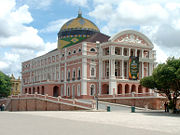
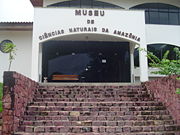
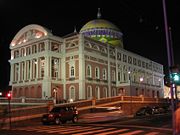
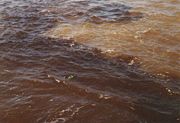


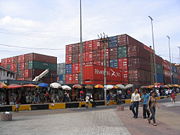
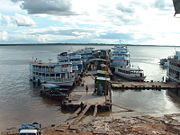


A
- Acariquara
- Adrianópolis
- Ajuricaba
- Aleixo
- Amercromby
- Américo Medeiros
- Aparecida
- Armando Mendes
- Amazonino Mendes
B
- Bairro da Paz
- Bairro da União
- Bairro Novo
- Bela Vista
- Betânia
- Belvedere
- Belo Horizonte
- Ben Hur
- Braga Mendes
C
- Cachoeirinha
- Campos Elíseos
- Campos Sales
- Castanheira
- Ceasa
- Centro
- Chapada
- Cidade Nova
- Cidade de Deus
- Colônia Antônio Aleixo
- Colônia Oliveira Machado
- Colônia Santo Antonio
- Colônia Terra Nova
- Colina do Aleixo
- Compensa
- Conjunto 31 de março
- Coroado
- Crespo
D
- Dom Pedro I
- Dom Pedro II
- Déborah
- Distrito Industrial
- Duque de Caxias
E
- Educandos
- Eldorado
F
- Flamanal
- Flores
- Florestal
- Franceses
- Fortaleza
G
- Galiléia
- Gilberto Metrinho
- Glória
- Grande Vitória
I
- Inuyashaa
- Isicis
H
- Hiléia
J
- Japiim
- Japiinlândia
- Jardins
- Jardim América
- Jardim Belém
- Jardim Curitiba
- Jardim Fortaleza
- Jardim Independente
- Jardim Manaus
- Jardim Paulista
- Jardim Porto Alegre
- Jardim Versalles
- João Paulo
- Jorge Teixeira
- Jornalistas
- José Bonifácio
K
- Kíssia
L
- Lagoa Verde
- Lírio do Vale
M
- Manôa
- Mauazinho
- Monte das Oliveiras
- Monte Pascoal
- Monte Sião
- Monte Sinai
- Morada do Sol
- Morro da Liberdade
- Mundo Novo
N
- Nossa Senhora das Graças
- Nossa Senhora de Fátima
- Nossa Senhora do Perpétuo Soccoro
- Nova Betânia
- Nova Canaã
- Nova Cidade
- Nova Conquista
- Nova Esperança
- Nova Floresta
- Nova República
- Nova Vitória
- Novo Aleixo
- Novo Israel
- Novo Reino
O
- Oswaldo Américo
- Oswaldo Frota
- Ouro Verde
P
- Parque 10 de Novembro
- Parque das Laranjeiras
- Parque das Nações
- Parque Riachuelo
- Parque São Pedro
- Praça 14 de Janeiro
- Petrópolis
- Planalto
- Ponta Negra
- Presidente Vargas
R
- Raiz
- Redenção
- Renato Souza Pinto
- Riacho Doce
- Ribeiro Júnior
S
- Santa Etelvina
- Santa Inês
- Santa Luzia
- Santo Agostinho
- Santo Antônio
- São Raimundo
- Santos Dumont
- São Francisco
- São Geraldo
- São Jorge
- São José
- São Lázaro
- São Lucas
- São Paulo
- Sol Nascente
T
- Tancredo Neves
- Tarumã
- Tiradentes
- Tropical
U
- União da Vitória
V
- Valparaíso
- Vale do Sinai
- Vieiralves
- Vila Amazonas
- Vila Buritis
- Vila da Prata
- Vila Marinho
- Vila Real
Z
- Zumbi dos Palmares
Events
- February – Amazonas Carnival – samba schools parade at the ‘sambodromo’ in the Convention Center
- May – Ponta Negra’s Music Festival
- May - Festival Amazonas de Opera (Opera Festival)
- June – Amazonas Folklore Festival
- July - Festival Amazonas Jazz
- June 29 – São Pedro Fluvial Procession
- September 5 - The elevetion of Amazonas a Brazilian province category
- October 24 – Anniversary of Manaus
- November - Amazonas Film Festival
- December 31 – Ponta Negra’s New Year’s Eve Party
Sights of interest
Amazonas Theater
The Amazon Theatre has 700 seats and was constructed with bricks brought over from Europe, French glass and Italian marble. Several important opera and theater companies, as well as international orchestras, have already performed there.
Ponta Negra Cultural, Sport and Leisure Park
Ponta Negra beach, located 13 km from downtown Manaus, is one of the city's most important tourist attractions. The complex has beach volleyball courts, cycle way, a belvedere, playground, a medical center and a large sidewalk with bars, restaurants and snack bars. It also has an amphitheater with capacity for 15 thousand people, dressing room, and infrastructure for shows.
Public Swimming Areas
The Tarumã, Tarumãzinho and Cachoeira das Almas bayous (branches of rivers), located near the city, are places of leisure for the population on weekends. Manaus has several public swimming areas that are being remodeled and urbanized lately. There are also many private clubs that can be visited.
Approximately 100 km above Manaus, near the Township of Novo Airão, on the Negro River, there is Anavilhanas, the world's largest archipelago of fluvial islands. There are about 400 islands covered with native forest. During the dry season, the receding waters reveal several white sand beaches and natural formations of roots and trunks.
Meeting of the Rivers
This natural phenomenon is caused by the confluence of the Negro River's dark water and the Solimões River's muddy brown water that come together to form the Amazonas River. For 6 km, both rivers waters run side by side, without mixing. This phenomenon is caused by the great difference between the water temperatures and current speeds. The Negro River flows approximately 2km/h at 28°C, while the Solimões River flows 4 to 6 km/h at 22°C.
Adolpho Ducke Botanical Garden
The Adolpho Ducke Botanical Garden, inside a 100 km² ecological reserve, is the world's largest, with a huge number of plant and animal species.
Municipal Park of Mindú
It is located in an urban area, in the November 10 Park district. It was created in 1992 to be an area of ecological interest. It covers an area of 330.000 m² (33 ha) of forest remaining from the Township, used for scientific, educational, cultural and tourist activities. It is one of the last habitats for the sauim-de-coleira, a species of monkey that only exists in the Manaus region and is threatened with extinction. It is possible to walk through four distinct ecosystems in the park: land covered by secondary growth, firm ground brush, sandbanks and degraded areas that were illegally cleared in 1989. The Park also has a Library, with an information center on the environment connected to the Internet. It also has a parking area, amphitheater for 600 people, gardens planted with medical and aromatic herbs, orchid nursery, above ground trail and signs aiming to develop environmental education programs.
The Science Grove
The Grove is located in the INPA's – Amazonas National Institute for Research – area. The Grove's main attractions are: otter vivarium, manatee hatchery, bee hives, Science House, educational trails, alligator’s vivarium, botanical garden, above ground trail, free fauna, orchid nursery and bromeliad nursery.
Zoo
The zoo is open to the public. It is managed by the Brazilian Army and has approximately 300 species of animals from Amazonas fauna.
Beaches and Waterfalls
For outings to beaches and parks situated near the city, it is often necessary to use boats. The beaches are formed right after the river water level starts dropping, which lasts from August to November. Starting in December, as the river rises, the waters invade the sand and the woods on the banks.
Paricatuba Waterfall
This waterfall, located on the right bank of the Negro River, along a small tributary, is formed by sedimentary rocks, surrounded by abundant vegetation. Access is by boat. The best time to visit is from August to February.
Love Cascade
This cascade, located in the Guedes bayou, with cold and crystal clear water, is accessible only by boat and, then, hiking through the Forest.
Tupé Beach
Approximately 34 km from Manaus, this beach is well frequented by bathers on holidays and weekends. It is accessible only by boat. When the Negro River waters rise, the beach is restricted to a 20 m width and when they recede, it can reach 80m.
Moon Beach
It is located on the left bank of the Negro River, 23 km from Manaus. It is accessed only by boat. The beach is shaped like a crescent moon and is surrounded by rare vegetation, with a great stretch of sand and clear, cold water.
Lion Waterfall
This waterfall is located on km 34 of the AM 010 highway (Manaus-Itacoatiara). Bathing in the cold and clear waterfall is allowed.
Sports
Manaus is one of the 18 remaining candidates to host games of the 2014 FIFA World Cup, which Brazil was chosen to host.
References
- ↑ Turner, I.M. 2001. The ecology of trees in the tropical rain forest. Cambridge University Press, Cambridge. ISBN 0-521-80183-4
- ↑ Amazon Rainforest, Amazon Plants, Amazon River Animals
- ↑ Manaus, Brazil
- ↑ (in Portuguese) (PDF)GDP. Manaus, Brazil: IBGE. 2005. ISBN 85-240-3919-1. http://www.ibge.gov.br/home/estatistica/economia/pibmunicipios/2005/tab01.pdf. Retrieved on 2007-07-18.
- ↑ (in Portuguese) (PDF)per capita income. Manaus, Brazil: IBGE. 2005. ISBN 85-240-3919-1. http://www.ibge.gov.br/home/estatistica/economia/pibmunicipios/2005/tab01.pdf. Retrieved on 2007-07-18.
External links
- The Best from Manaus (in Portuguese).
- Manaus Official Site (in Portuguese).
- Globo Site Manaus Online – portal for Manaus (in Portuguese).
- Historic Teatro Amazonas.
- National Institute of Amazonian Research website (in Portuguese and English).
- Federal University of Amazonas website (in Portuguese).
- Manaus travel guide from Wikitravel
|
||||||||||||||||||||||||||
|
|||||||||||||||||||||||||||||
|
||||||||||||||||||||
|
|||||

